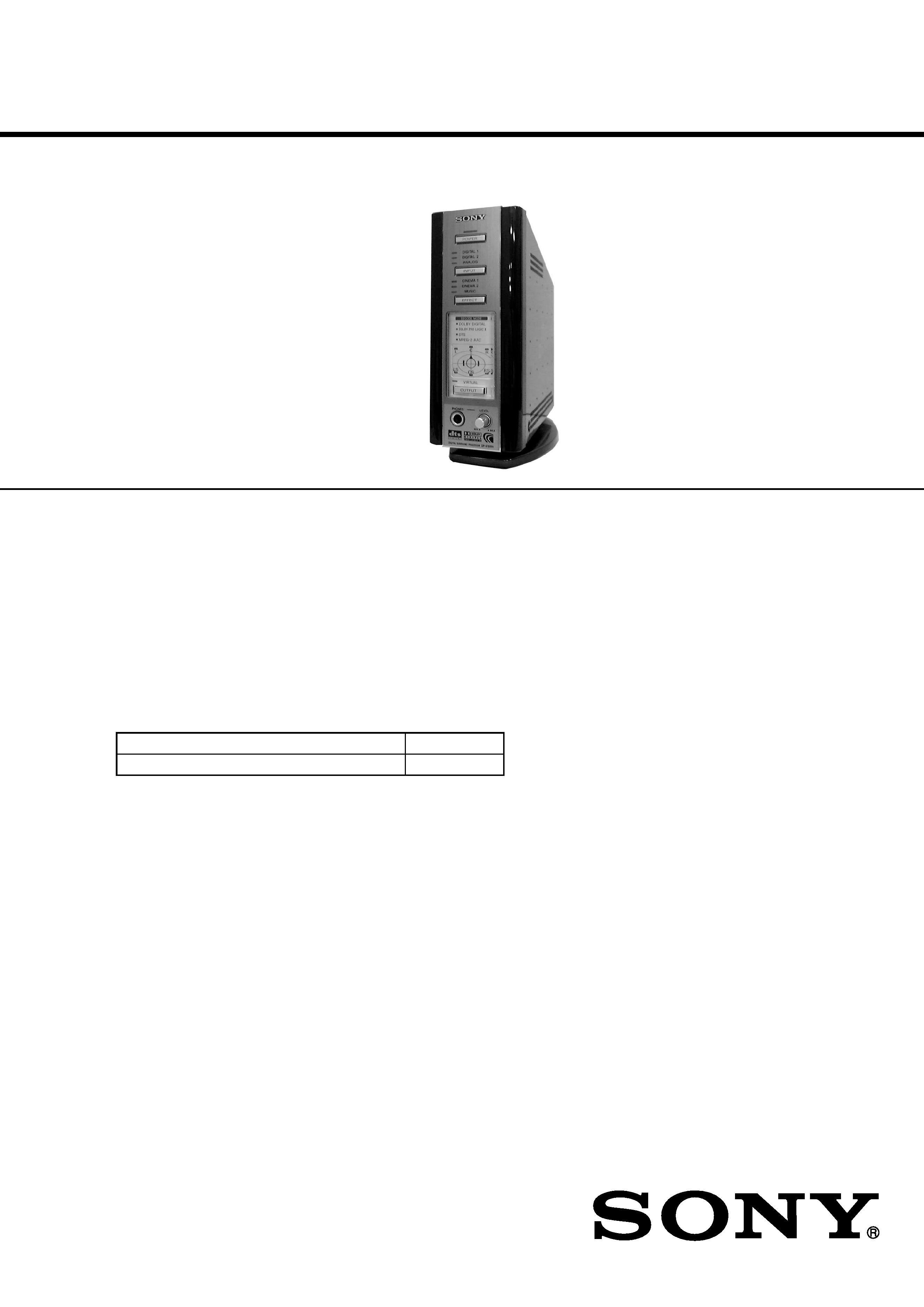
US Model
Canadian Model
AEP Model
SERVICE MANUAL
DIGITAL SURROUND PROCESSOR
SPECIFICATIONS
DP-IF8000
Ver 1.0 2002.02
Sony Corporation
Parsonal Audio Company
Published by Sony Engineering Corporation
9-873-528-01
2002B0200-1
© 2002. 02
·
Manufactured under license from Dolby Laboratories and Digital
Theater Systems,Inc.
"Dolby ","AC-3 ","Pro Logic ",the "AAC " logo and the double-D
symbol ; are trademarks of Dolby Laboratories.
"DTS " and "DTS VIRTUAL " are trademarks of Digital Theater
Systems, Inc.
·
DP-IF8000 is the component model block one in
MDR-DS8000.
COMPONENT MODEL NAME FOR MDR-DS8000
DIGITAL SURROUND PROCESSOR
DP-IF8000
CORDLESS STEREO HEADPHONES
MDR-IF8000
Decoder functions
Dolby Digital
Dolby Pro Logic II
DTS
DTS-ES 6.1ch
MPEG-2 AAC
Virtual sound function
OFF
Virtual front
Virtual surround 5.1 & 6.1
Modulation System
DQPSK
Secondary carrier wave frequency
4.5 MHz
Transmission distance
Approx. 10 m to the front
Transmission range
12 24,000 Hz
Distortion rate
1% or less (1 kHz)
Audio inputs
Optical input
(rectangular-type)
× 2
Analogue input
(pin jack left/right)
× 1
Power requirements
DC 9 V (from the supplied AC
power adaptor)
Dimensions (w/h/d)
Approx. 85
× 190 × 200mm (3 3/8×
7 1
/2 × 7 1/8 inch)
Mass
Approx.1.0 kg(2 lb 30 oz)
Design and specifications are subject to change without notice.
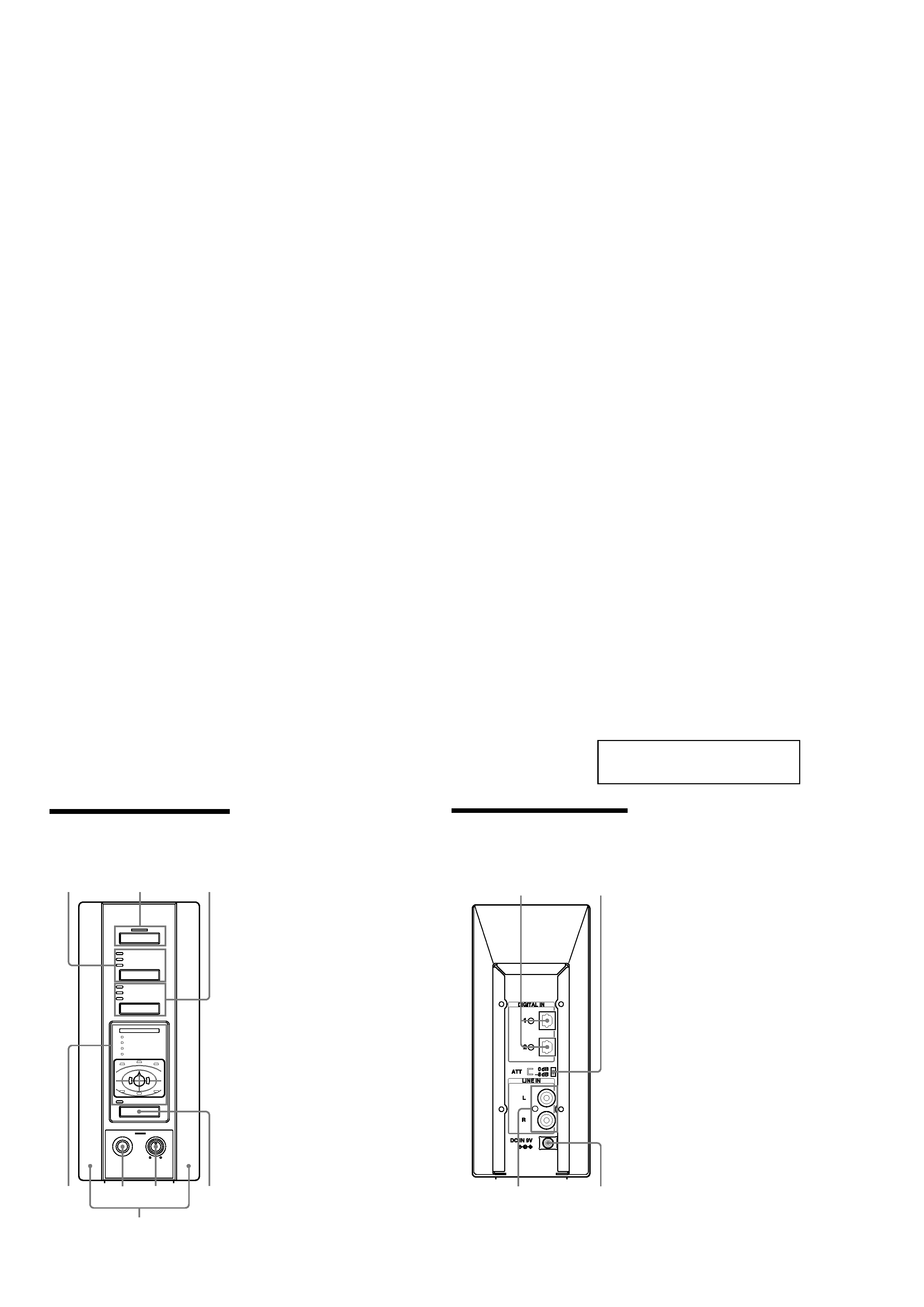
2
DP-IF8000
SAFETY-RELATED COMPONENT WARNING!!
COMPONENTS IDENTIFIED BY MARK 0 OR DOTTED LINE WITH
MARK 0 ON THE SCHEMATIC DIAGRAMS AND IN THE PARTS
LIST ARE CRITICAL TO SAFE OPERATION. REPLACE THESE
COMPONENTS WITH SONY PARTS WHOSE PART NUMBERS AP-
PEAR AS SHOWN IN THIS MANUAL OR IN SUPPLEMENTS PUB-
LISHED BY SONY.
ATTENTION AU COMPOSANT AYANT RAPPORT
À LA SÉCURITÉ!
LES COMPOSANTS IDENTIFÉS PAR UNE MARQUE 0 SUR LES
DIAGRAMMES SCHÉMATIQUES ET LA LISTE DES PIÈCES SONT
CRITIQUES POUR LA SÉCURITÉ DE FONCTIONNEMENT. NE
REMPLACER CES COMPOSANTS QUE PAR DES PIÈSES SONY
DONT LES NUMÉROS SONT DONNÉS DANS CE MANUEL OU
DANS LES SUPPÉMENTS PUBLIÉS PAR SONY.
Notes on chip component replacement
· Never reuse a disconnected chip component.
· Notice that the minus side of a tantalum capacitor may be
damaged by heat.
Flexible Circuit Board Repairing
· Keep the temperature of soldering iron around 270°C during
repairing.
· Do not touch the soldering iron on the same conductor of the
circuit board (within 3 times).
· Be careful not to apply force on the conductor when soldering
or unsoldering.
Flexible Circuit Board Repairing
TABLE OF CONTENTS
1. GENERAL .......................................................................... 2
2. SERVICING NOTES ........................................................ 3
3. DISASSEMBLY
3-1. Cover ................................................................................... 9
3-2. Chassis (processor), "Panel ASSY, Front" .......................... 9
3-3. TX Board .......................................................................... 10
3-4. LED Board, AMP Board ................................................... 10
4. TEST MODE ......................................................................11
5. ELCTORICAL AJUSTMENT.........................................12
6. DIAGRAMS
6-1. Explanation of IC Terminal ............................................... 13
6-2. Block Diagram (1/2) ....................................................... 18
6-3. Block Diagram (2/2) ....................................................... 19
6-4. Printing Wirning Board LED Section .......................... 20
6-5. Schematic Diagram LED Section ................................ 21
6-6. Printed Wiring Board TX Section ................................ 22
6-7. Schematic Diagram TX Section (1/4) .......................... 23
6-8. Schematic Diagram TX Section (2/4) .......................... 24
6-9. Schematic Diagram TX Section (3/4) .......................... 25
6-10. Schematic Diagram TX Section (4/4) ......................... 26
7. EXPLODED VIEWS ........................................................ 29
8. ELECTRICAL PARTS LIST ........................................30
SECTION 1
GENERAL
This section is extracted from
instruction manual.
Front Panel of the
Processor
1
DIGITAL 1,2 input indicator
ANALOG input indicator
INPUT button
Press to select the input source (DIGITAL
1/DIGITAL 2/ANALOG).
2
POWER indicator
This indicator lights green when you
turn on the processor.
POWER switch
Press to turn on and off the processor.
3
CINEMA 1,2 indicator
MUSIC indicator
EFFECT button(see page 20 for
details)
Press to select the sound field (CINEMA
1/CINEMA 2/MUSIC).
4
Decode mode indicator(see page
19 for details)
5
PHONES jack(see page 20, 24 for
details)
Connect your headphones to this jack.
Connect the MDR-F1 headphone (sold
separately) for optimum surround effect.
6
PHONES -- LEVEL control
Turn to adjust the volume of the
headphones (sold separately) connected
to the PHONES jack.
7
OUTPUT button
Press to select the output mode (OFF/
VIRTUAL FRONT/VIRTUAL
SURROUND).
8
Infrared emitter
Set the emitter in a position so that there
is a straight, unobstructed path to the
sensor.
PHONES
LEVEL
MIN
MAX
VIRTUAL
OUTPUT
L
POWER
DIGITAL 2
ANALOG
DIGITAL 1
INPUT
CINEMA 1
CINEMA 2
MUSIC
EFFECT
DECODE MODE
DOLBY DIGITAL
DOLBY PRO LOGIC II
DTS
C
R
LS
RS
CS
MPEG-2 AAC
1
6
7
8
5
12
3
Rear Panel of the
Processor
1
DIGITAL IN 1,2 jack (see page 13 for
details)
Connect a DVD player, Digital TV,
Digital Broadcasting Satellite Receiver,
LD player, or other digital component
(sold separately) to this jack.
2
ATT (attenuator) switch
Set this switch to 0dB when the volume is
too low at analogue input. Normally, this
switch should be set to 8dB.
3
LINE IN jack (see page 14 for details)
Connect the audio output jack on audio/
video equipment (sold separately), such
as a video cassette player or TV, to this
jack.
4
DC IN jack
Connect the supplied AC power adaptor
to this jack. (Be sure to use the supplied
AC power adaptor. Using products with
different plug polarity or other
characteristics can cause a malfunction.)
12
34
LOCATING THE CONTROLS
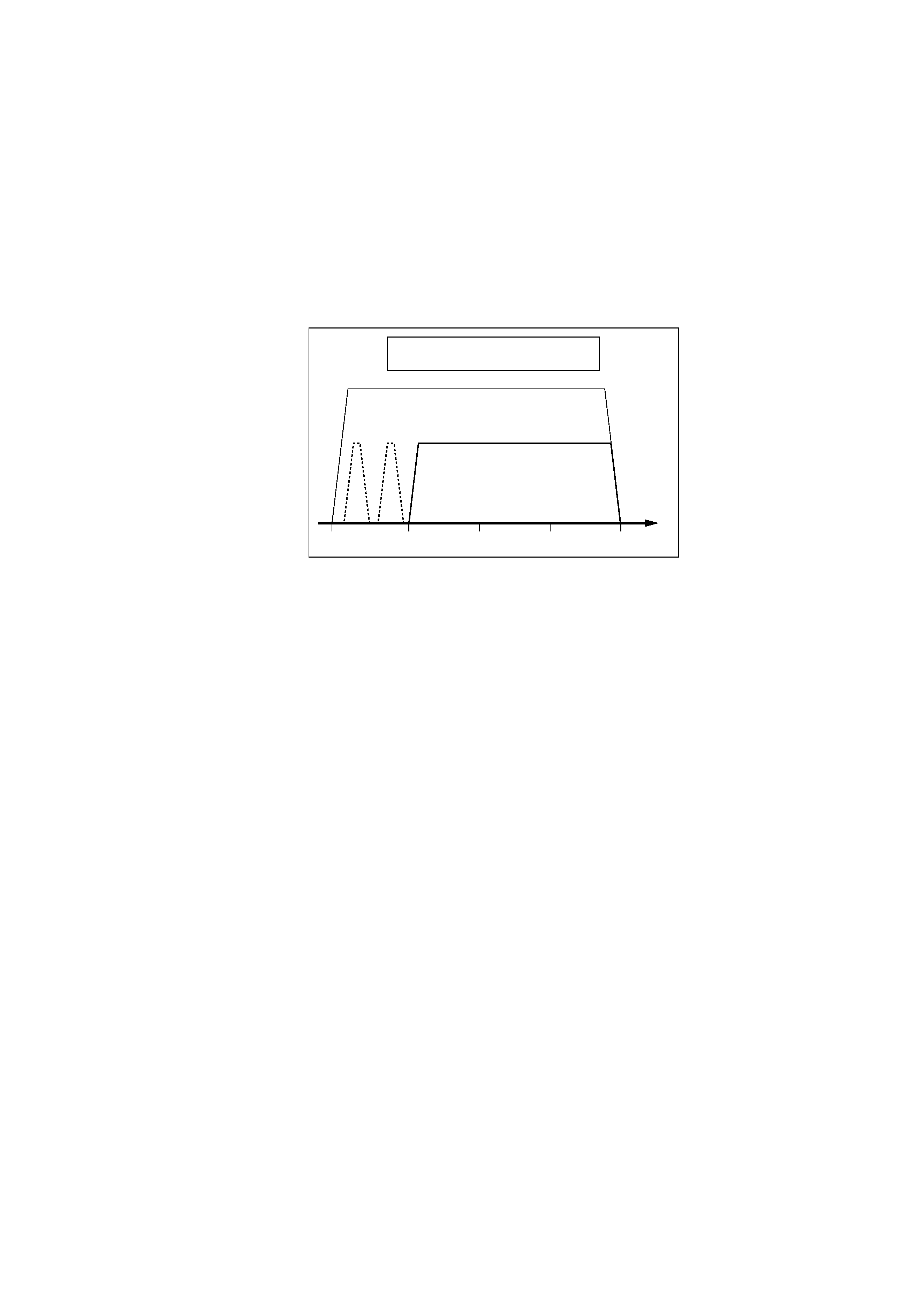
3
DP-IF8000
SECTION 2
SERVICING NOTES
DIAT
(DIGITAL INFRARED AUDIO TRANSMISSION)
High quality media such as DVD and digital broadcasts are currently going through a phase of explosive expansion. To convey these kinds
of high quality media to listeners with no loss in sound nuance or quality, a new technology called DIAT has been developed using the MDR-
DS8000 to transmit these digital audio signals by infrared without harmful data compression.
DIAT technology allows transmitting digital audio signals without data compression on a portion of the sub-carrier frequency bandwidth
allotted to distributing high-fidelity audio by the IEC (International Electrotechnical Commission) and JEITA (Japan Electronic Information
Technical Association). The transmission quality is equal to or better than that on compact discs (CD). (Fig. 2-6)
L
2
3
46
Hi-Fi audio data transmission bandwidth
(2 to 6 MHz)
Analog transmission
Digital transmission (DIAT)
[MHz]
R
5
Fig. 2-6 Signal spectrum for digital infrared transmission
[Reference Data]
Sub-carrier frequency
: 4.5 MHz
Occupied bandwidth
: 2.5 MHz (approx.)
Data rate
: 3 Mbps (approx.)
Modulation method
: DQPSK
(differential quadrature phase shift keying)
Transmit error correction : Reed Solomon coding
DIGITAL INFRARED AUDIO TRANSMISSION
Along with developing a custom IC, the number of light-emitter elements were doubled (to 16) and light-receiver elements increased 6-fold
(to 24) to achieve a carrier-to-noise signal ratio well capable of transmitting wide-band digital signals. Using digital transmission eliminates
the transmission hiss noise heard in conventional analog broadcasts and allows listeners to enjoy hearing even small sounds.
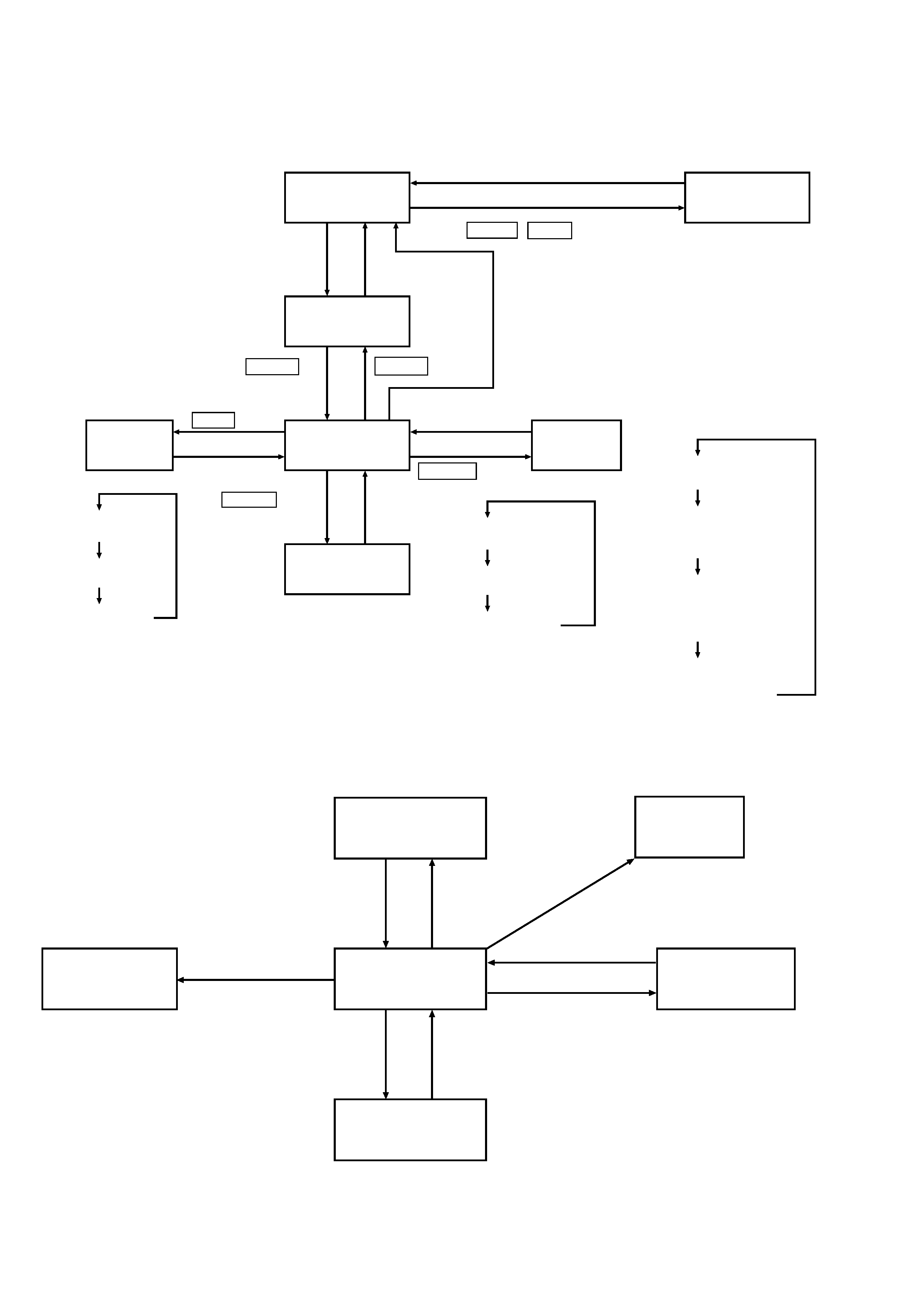
4
DP-IF8000
1. STATUS TRANSITION DRAWING
1.1
Processor
ALL POWER OFF
(LEDs all off)
TEST
MODE
POWER OFF
(LEDs all light up)
INPUT
CHANGE
OUTPUT
CHANGE
EFFECT
CHANGE
Unplug the AC adapter
POWER key
POWER key
Press EFFECT key
while in Virtual output
mode
INPUT key
OUTPUT key
After operation change
After operation change
After operation
change
OFF out put
(L-HLch, L-HRch lights up)
Virtual front output
(L-FLch, L-FRch, L-VIRTUAL
lights up)
5.1ch virtual output
(L-FLch, L-FCch, L-FRch
L-SLch, L-SRch, L-VIRTUAL
lights up)
6.1ch virtual output
(L-FLch, L-FCch, L-FRch
L-SLch, L-SCch, L-SRch,
L-VIRTUAL lights up)
CINEMA1 sound effect
(L-CINEMA1 lights up)
CINEMA2 sound effect
(L-CINEMA2 lights up)
MUSIC sound effect
(L-MUSIC lights up)
Digital input 1 enabled
(L-DIGITAL 1 lights up)
Digital input 2 enabled
(L-DIGITAL 2 lights up)
Analog input enabled
(L-ANALOG lights up)
Unplug the AC
adapter
Unplug the AC adapter
Connect the AC adapter
Connect AC adapter while simultaneously
pressing POWER & INPUT
POWER ON
(operation LED lights up)
1.2 Headphones
POWER OFF
(L-POWER off)
POWER ON
(L-POWER lights up)
EFFECT
CHANGE
EFFECT
CHANGE
· Virtual output (head trcking on)
· Virtual output (head trcking off)
LOW BATTERY
operation
Place headphones on head.
When LOW BATTERY
is detected
When virtual output (processor output)
is changed or S-HT changed while S-HT
is enabled.
Remove headphones
When switched to stereo-thru
output (processor output)
Receive error
operation
Processor infrared ray output to
OFF at transmit limit or cutoff.
After operation change
After operation change
Through output
(head tracking off)
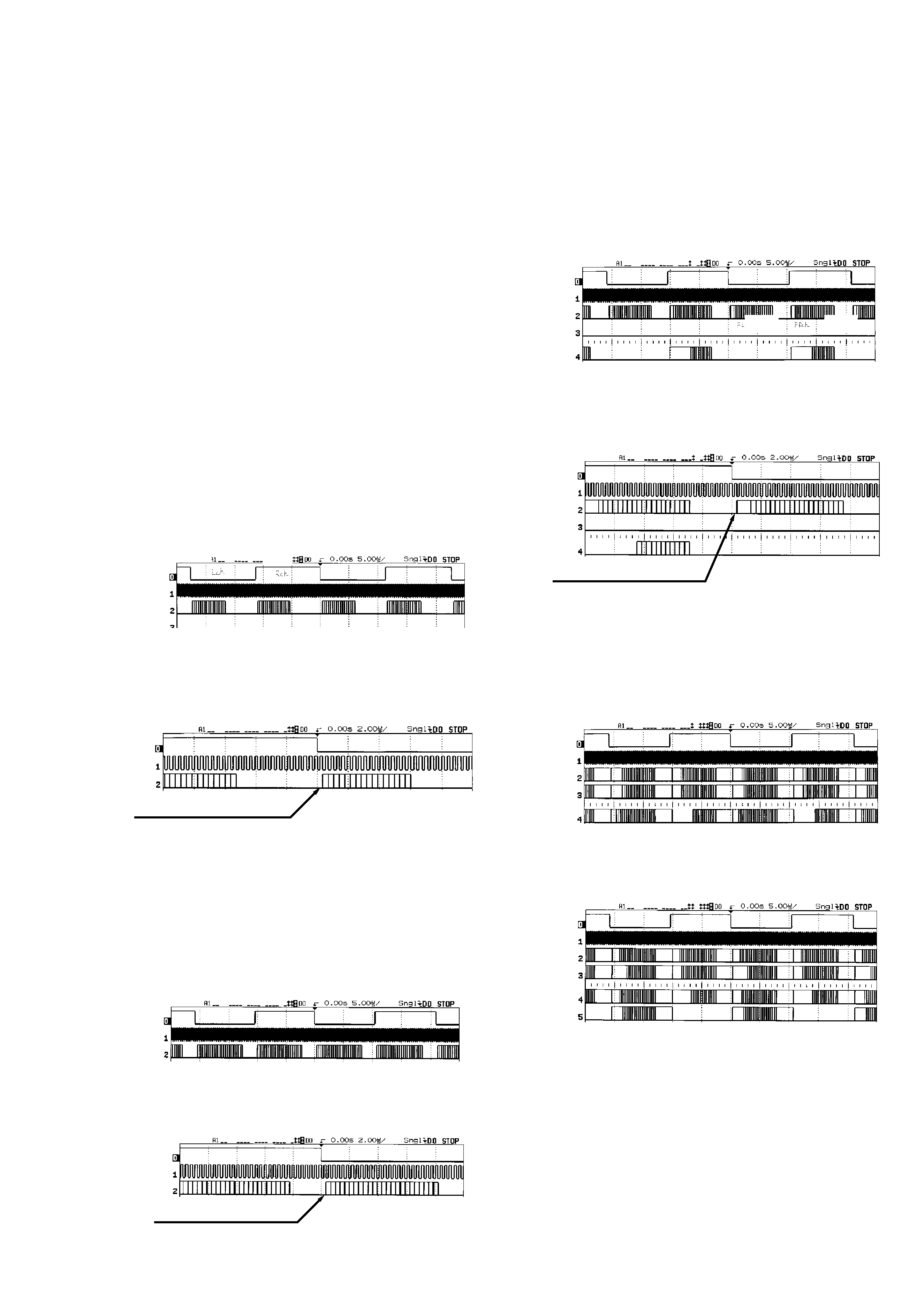
5
DP-IF8000
2. WAVEFORMS & TIMING OF MAIN SIGNAL LINES
2.1 Processor
2.1.1 Audio system
Note: Switch to Digital Input mode by connecting the optical cable
to DIGITAL IN 1 or 2, and pressing the INPUT key.
Switch to Analog Input mode by connecting the audio cable
to LINE IN, and pressing the INPUT key.
· Master clock
MCK (IC12-104pin) : 12.288 MHz (fixed)
MCKADDA (IC5-6pin) : 12.288 MHz (fixed) when in analog
input mode;
When in Digital Input mode, 12.288 MHz for an input source
sampling frequency of 48 kHz.
11.298 MHz for an input sampling frequency of 44.1 kHz; 8.192
MHz for an input sampling frequency of 32 kHz
· DIR-DECODER period
Check LRCK (IC11-12pin), BCK (IC 11-14pin), INDATA (IC11-
10pin).
At power-ON, and in Digital Input mode, any playback source is
okay.
Monitor view is shown in Fig. 1 and detailed timing is shown in
Fig. 2.
Fig 2
LRCK
BCK
INDATA
16 bit
1 bit offset (I2S format)
Fig1
LRCK
BCK
INDATA
Lch
Rch
Note 1: Example shows 44.1 kHz for LRCK; 48 kHz and
32 kHz are also used.
Fig 3
LRCK
BCK
INDATA
Lch
Rch
Note 2: LRCK is fixed at 48 kHz.
· ACD-DECODER period
Check LRCK (IC11-12pin), BCK(IC 11-14pin), INDATA (IC11-
10pin).
At power-ON, and in Digital Input mode, any playback source is
okay.
Monitor view is shown in Fig. 3 and detailed timing is shown in
Fig. 4.
Fig 4
LRCK
BCK
INDATA
24 bit
1 bit offset (I2S format)
Fig 5
LRCK
BCK
FLRSG
SLRSG
CLFSG
LFE
FLch
FRch
Note 3: Example shows 48 kHz for LRCK, but 44.1 kHz and
32 kHz may also be used.
· DECODER-MAIN DSP period
Check LRCK (IC11-12pin), BCK (IC 11-14pin), FLRSG (IC11-4pin),
SLRSG (IC11-5pin), CLFSG (IC11-6pin), OTHSG (IC11-7pin).
The playback source at power-ON, and Digital Input mode is Dolby
Digital or DTS, or a 5.1ch source for MPEG-AAC.
The view on the monitor when OFF or VIRTUAL FRONT is se-
lected with the OUTPUT key is shown in Fig. 5. The detailed timing
is shown in Fig. 6.
Fig 6
LRCK
BCK
FLRSG
SLRSG
CLFSG
1 bit offset (I
2S format)
Fig. 7 shows the monitor view when VIRTUAL 5.1 is selected with
the OUTPUT key. (Detailed timing is the same as in Fig. 6.)
Fig. 8 shows the monitor view when VIRTUAL 6.1 is selected with
the OUTPUT key. (Detailed timing is the same as in Fig. 6.)
Fig 7
LRCK
BCK
FLRSG
SLRSG
CLFSG
FL
FR
SL
SR
C
LFE
Note 3: Example shows 48 kHz for LRCK, 44.1 kHz and
32 kHz are also used.
Fig 8
LRCK
BCK
FLRSG
SLRSG
CLFSG
OTHSG
FL
FR
SL
CS
SR
C
LFE
Note 3: Example shows 48 kHz for LRCK, 44.1 kHz and
32 kHz are also used.
· MAIN DSP-DAC period
Check LRCK (IC5-5pin), BCK (IC5-4pin), VPOUT2 (IC15-3pin).
At power-ON, and Digital Input mode or Analog Input mode, any
playback source is okay.
A monitor view is shown in Fig. 9 and the detailed timing is shown
in Fig. 10.
